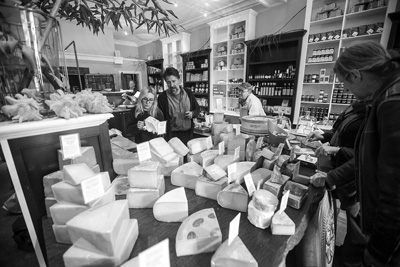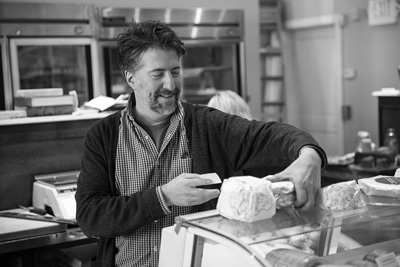News & Issues December 2016-January 2017
‘Art you can eat’
Taste, history inspire Barrington’s keeper of cheeses
 By STACEY MORRIS
By STACEY MORRIS
Contributing writer
GREAT BARRINGTON, Mass.
Customers examine the offerings at Rubiner’s Cheesemongers & Grocers in Great Barrington. The store’s owner, Matthew Rubiner, center, has been a serious student of cheese for more than two decades.Scott Langley photo
Matthew Rubiner stands deep in concentration, illuminated by morning sunlight that spills across the wooden floor from the front windows of his shop in an imposing former bank building on Main Street.
To the uninitiated, the owner of Rubiner’s Cheesemongers & Grocers is simply standing over a refrigerator case full of cheese.
But to serious cheese lovers, Rubiner is the curator overseeing a collection of treasures: artisan bries, camemberts and azure wedges of blue cheeses, all of which he has just reassembled for a new day’s display.
Rubiner spends the first part of each day transporting his edible inventory from the basement to various display stations throughout the store. During the course of the day, the dozens of varieties will be studied, sampled and purchased by his loyal clientele – and by tourists wandering in for the first time.
At day’s end, every wedge and wheel of cheese will be carefully sequestered to subterranean storage for the night. It’s all part of the duty cycle that a cheesemonger willingly undertakes for his craft.
“The more aged, lower-moisture cheeses are displayed at room temperature, while the younger, moister varieties are displayed under refrigeration,” he explained. “In the most basic sense, no cheese requires refrigeration … if you are content to let a cheese a live out its natural life, which may be years or days. The whole point of cheese, you could say, is to preserve milk when refrigeration was not an option thousands of years ago.”
Rubiner has been a serious student of cheese for more than two decades and says he’s still learning new things. He’s in his element discussing it.
“A fresh goat cheese will last a few days out of refrigeration before spoiling,” he explained. “A brie, depending on how ripe it is, will last, and more importantly, continue to develop, for many days. An aged gouda will last for years -- provided it doesn’t dry out.
“But we aren’t content to let a cheese live out its natural life,” he added. “For business and health code reasons, we need to store more perishable cheeses under refrigeration. And each morning, it’s brought up from the cellar, inspected and cleaned. Cheese is a living, breathing thing. … Much of the job entails caring for my wards.”

Linking producer, consumer
After a brief stint operating in the town of Richmond, Rubiner’s Cheesemongers & Grocers has been a fixture in the heart of Great Barrington since 2004.
Over the past decade, the production of fine cheeses has soared to new heights in the United States and regionally.
“But I’ve always been oriented to Europe,” Rubiner said. “Some of the best still comes from there.”
Still, many of the cheeses he sells are produced locally, and some are culled from small-scale producers across the nation. No matter where the cheese is from, Rubiner’s standard doesn’t waver: The cheese must be made on a limited scale within acceptable production circumstances, including the treatment of animals.
“A cheesemonger serves as a link that shortens the distance between a maker and the buyer,” he explained. “We’re practitioners of an ancient trade. What we offer is expertise on the product. Cheese can change over the course of a day. The same cheese can be a different experience each time you eat it. That’s why we insist customers try before they buy, because cheese is always evolving. From a single bite you can discern the type of animal, the climate, even the terrain of the farm.”
Hardier, aged cheeses are displayed on marble slabs, with handwritten signs that tell the cheese’s name, origin, price per pound, and other information. There are globes of raw goat’s milk chevre from Belgium; a peppercorn-studded aged goat cheese from Ann Arbor, Mich.; firm wedges of Andalusian queso payoyo; Abbaye de Belloc, a farmhouse, semi-hard cheese from the French Pyrenees; and Flory’s Truckle, an aged, cloth-bound cheddar from Jamesport, Mo. Rubiner said his prices range from $16 to $20 per pound, on average.
“I’ve always felt the customers here care very much about what they eat and who makes their food,” he said.
Though he was reluctant to pick a favorite, he paused a moment before confessing to a particular fondness for Jasper Hill Farm’s Harbison, a soft-ripened cow’s milk cheese made in Greensboro, Vt.
“I could make a case for it being the best American cheese there is,” he said, smiling at the thought of it.
More than a few of the cheeses on his shelves can be found at supermarkets, he acknowledged.
“But we give customers information on the farm itself, the history of the cheese, proper pairings, and the extended care of the cheese once it’s home,” Rubiner added.
As for worthy food and condiment pairings for his cheeses, many can be found on the store’s floor-to-ceiling shelves: flasks of aged Worcestershire from England, bottles of flaming red anchovy oil, jars of honey from Italy, chocolate-covered figs, pastas from Italy, potato chips from Spain, giant squares of caramel from Paris.
“We’ve always sold more than cheese from the start,” Rubiner said.
Leaving academics for artisans
Rubiner’s immersion in the world of cheese began in the early 1990s, when he apprenticed at Formaggio Kitchen in Cambridge. Disenchanted with his research job at the Massachusetts Institute of Technology, where he was on track to a doctorate and a life as a defense analyst, Rubiner decided his career should match his passion.
“After visiting Italy for the first time, I was very struck by the idea of being surrounded with beautiful food, wine, and places that grow and produce,” he recalled. “How could you not be happy?”
After returning to the states, Rubiner began laying groundwork for how he could enter the food industry.
“I don’t have a chef’s temperament, and I’m not a salesman,” he said. “Cheese always attracted me. Being from an academic background, I love that I can make a lifelong inquiry out of cheese and still not scratch the surface. I’ve been doing this for 25 years, and literally not a day goes by when I don’t say, ‘How did I not know that?’”
Though well-meaning friends urged him to choose a more populated setting for his cheese shop, Rubiner says he never doubted Great Barrington’s viability for his vision.
“I loved the idea of a country cheese shop amongst growers and producers,” he recalled. “And Great Barrington’s as beautiful as any place in the world. I prefer nature that’s had the hand of man lightly laid upon it.”
To showcase both his cheese inventory and the locally roasted coffee varieties from Barrington Roasters, he opened Rubi’s Café, in an intimate space behind the cheese store, in 2004. The café is beehive of activity during the breakfast and lunch hours, serving an array of coffee drinks and a menu filled with egg dishes, pastries, and hot sandwiches – including, of course, grilled-cheese sandwiches.
Both the cheese shop and the café have their share of celebrity clients – some with ties to the region, such as James Taylor and Meryl Streep.
“And then we’ll get random celebrities like Bette Midler and David Letterman,” Rubiner said. “We also get tons of fashion industry and chefs, which affirms a lot of what we’re trying to do: We want to have a pretty, well-appointed store which has an unrelenting level of quality and, dare I say, taste.”
In a recent radio interview, Ruth Reichl, the former Gourmet magazine editor who lives just across the New York state line in Columbia County, described Rubiner’s cheese selection as “beautifully curated.”
And Rubiner embraces the notion that he serves as a kind of editor or curator, carefully selecting and arranging his offerings.
“People like an inventory that’s been edited,” he said. “I like to think of what we have as art you can eat.”
In a world where veganism is trending, some might think the audience for cheese has reached its peak. But Rubiner said his clientele remains intensely devoted.
“If anything, cheese is more popular than ever,” he said. “Americans have a much broader appreciation of the varieties now. And there are schools of thought that maintain that cheese is one of the best protein sources one can eat.”
Besides accolades from customers, Rubiner has won numerous awards, including the 2010 inaugural National Cheesemongers Invitational. He has also served on the board of directors of the American Cheese Society and judged numerous competitions.
“You have to do something that’s going to satisfy some sort of sensual passion, … at least I do,” he said. “I’m never more content than working here after hours, communing with cheese. It resets me.”
For more information about Rubiner’s Cheesemongers & Grocers, visit www.rubiners.com.
